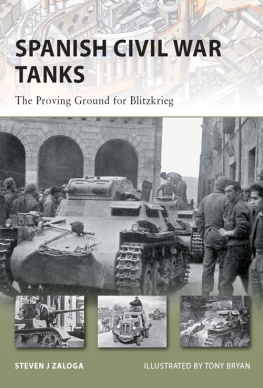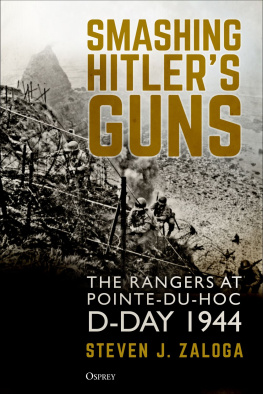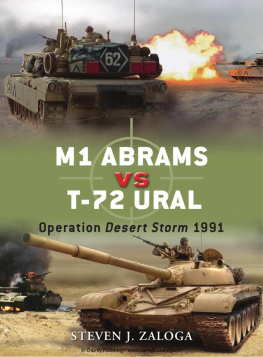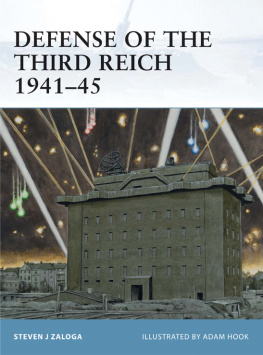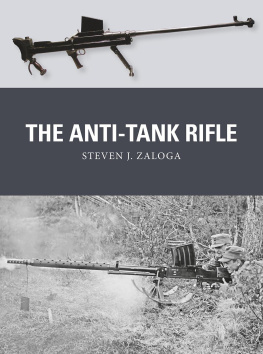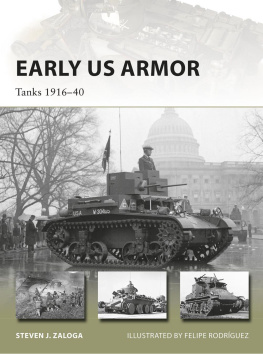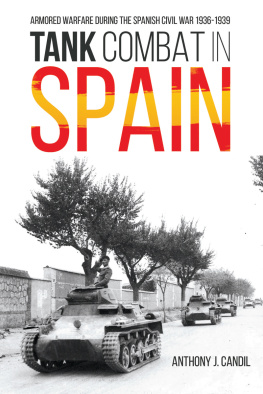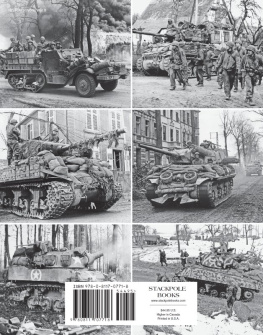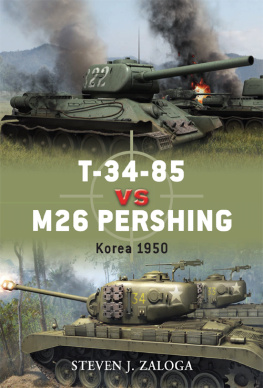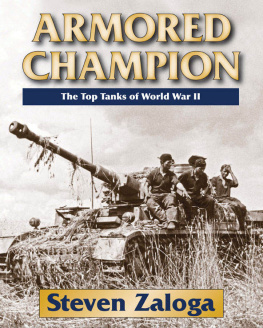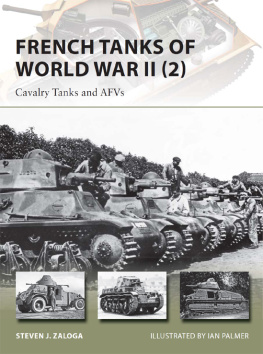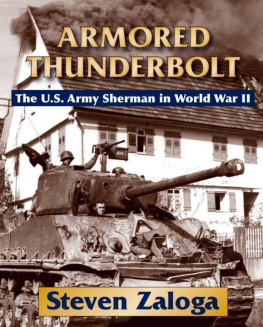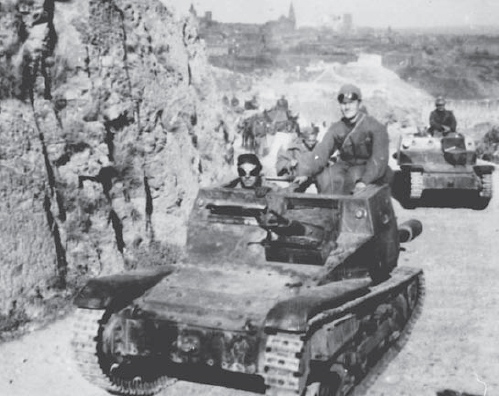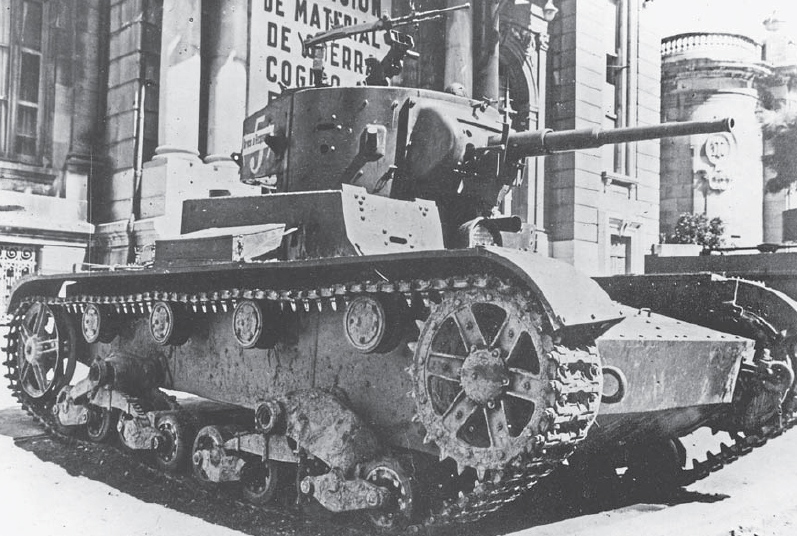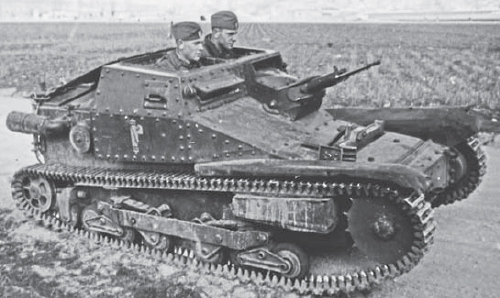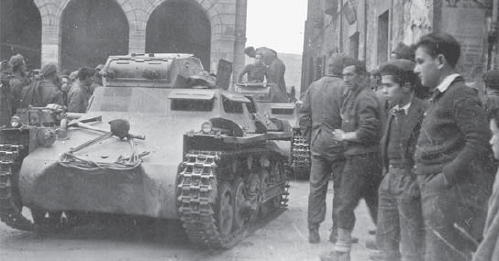NEW VANGUARD 170
SPANISH CIVIL WAR TANKS
The Proving Ground for Blitzkrieg
| STEVEN J ZALOGA | ILLUSTRATED BY TONY BRYAN |
CONTENTS
SPANISH CIVIL WAR TANKS
THE PROVING GROUND FOR BLITZKRIEG
INTRODUCTION
The Spanish Civil War was the first European conflict to see the extensive use of tanks since their debut in World War I. It came at a crucial time in European tank development, when production went from a few hundred tanks per year to many thousands. The Great Powers looked to the Spanish conflict to validate their own tank programs and to learn any important lessons about tank warfare. The Spanish Civil War has been regarded as the proving ground for blitzkrieg. Spain was seen as a laboratory for Germany, Italy, and the Soviet Union to test out their tanks and tactical doctrine on the eve of World War II.
The dominant tank in the Spanish Civil War was the Soviet T-26. This captured Republican T-26 Model 1937 was put on display in front of the Gran Kursaal in San Sebastin in 1938 after its capture near Tremp-Lrida. (NARA)
The Carro Veloce CV 3/35 was the most common version of the Italian tankette in service in Spain, though some of the earlier CV 3/33s were also used. The fasces marking on the superstructure side indicates a command vehicle. (NARA)
This book will argue that in fact the Spanish Civil War provided few clear tactical lessons. Tank employment in Spain was unique, and so no sober observer could draw any profound conclusions about the nature of future tank warfare. Tanks were used in relatively small numbers by poorly trained crews with little or no tactical understanding by senior commanders. Many armies did use the Spanish experience to validate their own preconceptions about tank warfare, but this was a misuse of the lessons. While the Spanish Civil War did not have a major impact on the development of tank doctrine, it had significant influence on tank design. The tanks used in the conflict were lightly armored and armed mostly with machine guns. The important exception was the Soviet T-26, which was armed with a powerful 45mm dual-purpose gun. This tank so dominated the Spanish battlefield that it ended once and for all the question about whether machine-gun-armed tanks were viable. They were not, and suddenly most European armies realized that their substantial investment in machine-gun-armed tanks in the early 1930s was seriously flawed.
Spain also saw the first widespread use of dedicated antitank guns, notably the German Rheinmetall 37mm and its Soviet copy, the 45mm antitank gun. When skillfully used, these weapons could prove to be an effective counter to rampaging tanks. While the Spanish conflict did not decisively demonstrate the relative balance between tank and antitank warfare, it strongly suggested that the cheap and lightly armored tanks of the 1930s were too vulnerable. The lessons of the war spurred the production of medium tanks, which would form the steel core of Europes armies in World War II.
TANK TECHNOLOGY ON THE EVE OF WAR
In the wake of World War I, most European armies neglected further tank development. An ample supply of tanks was still on hand from the war, and the meager defense budgets of the 1920s did not encourage expensive new programs. Germany was forbidden tanks under the Versailles Treaty and the Soviet Union was still licking its wounds after a debilitating civil war. Tank development began to accelerate in the early 1930s. The World War I tanks had been mechanically arthritic even in their prime, and by the 1930s were mostly worn out.
A PzKpfw I Ausf A of the 1st Batalln de Carros de Combate in Vergara during operations in the Basque country against the Army of the North in 1938. (John Prigent Collection)
Britain had been at the forefront of tank development in World War I, and was the most influential tank manufacturing country in the early 1930s. This was due not only to its weapons firms such as Vickers, but also to its visionary military thinkers such as J. F. C. Fuller, who wrote extensively on the nature of future war and the equipment needs of modern armies. One of the most influential developments in Britain was the Carden-Loyd tankette. This was a small, two-man vehicle armed with a single machine gun. From a tactical standpoint, these inexpensive tankettes could be built in large numbers and swarm over the battlefield in force. This was in fact an elaboration of the concepts of the French general Jean-Baptiste Estienne, which had spawned the Renault FT tank in 1917. Regardless of its tactical merits, the tankette idea was popular in Europe because such vehicles were so cheap. They seemed like a prudent choice when defense budgets were so meager. The Soviet Union adopted the Carden-Loyd under license as the T-27, Italy made a copy as the CV 3/33, and Poland built its own example as the TK. These tankettes were the most widely produced armored vehicles of the early 1930s and the Italian CV 3/35 would see extensive service in Spain.
Germany was not allowed tanks but the Reichswehr experimented with armored chassis under the guise of artillery tractors. Krupp had been given a contract to develop a light tractor in 1931 that was the surreptitious basis for a future tank. After Hitler came to power in 1933, the Versailles Treaty restrictions were renounced and the Krupp light tractor emerged as Nazi Germanys first tank, the Panzerkampfwagen I (PzKpfw I). This tank was significantly larger than tankettes and had a traversable turret. Technically, it was a further evolution of the French Renault FT of 1917 but with more modern automotive design. German tank design in 191718 had focused on the construction of small numbers of very large tanks, epitomized by the A7V, but these designs were clumsy and too costly. After this mistake during World War I, German opinion swung in favor of Estiennes view that a bee swarm of inexpensive tanks was more valuable than a handful of massive tanks. The PzKpfw I satisfied this tactical objective and was also essential in providing German industry with the technical lessons that would be needed for larger and more elaborate designs. The PzKpfw I was never designed to fight other tanks, since there had been hardly any instances of tanks fighting other tanks during World War I. The PzKpfw I was another of the interwar tank types to see extensive combat in Spain.

The T-26 was a license-built copy of the British Vickers 6-ton export tank, but fitted with a Soviet-designed turret armed with a 45mm gun derived from the German Rheinmetall 37mm antitank gun. The crew was three: a driver in the hull, and a gunner and loader/commander in the turret. This example is a captured T-26 in service with the 1st Batalln de Carros de Combate de la Legion in 1938. (NARA)
Another influential tank in the interwar years was the Vickers 6-ton tank. This was a commercial design intended for export, and the British Army never bought any significant number. It was sold to the Soviet Union, Poland, the United States, China, and several other countries. It inspired many World War II tank designs, including the US Armys M3 Stuart, the Italian M11/39 and M13/40, and the Polish 7TP. Its most important evolution was the Soviet T-26 light tank. As a commercial export product, several armament options were offered, including the Model A trench clearer fitted with two turrets, each with a light machine gun; the Model B fire support tank fitted with a single turret and short 47mm gun; and the Model C tank destroyer, which was configured like the Model A but had long 37mm antitank guns in the hull. The Soviet Union bought license production rights for the Vickers in 1930. Since the Red Army planned to deploy the T-26 for infantry support the twin-turret layout was selected, so that the tank could then engage two targets simultaneously. Although tank-vs-tank fighting was not considered a major tactical concern, work began in 1932 on a T-26 tank destroyer fitted with a single large turret armed with a 45mm antitank gun. An important innovation in this design was the incorporation of a coaxial machine gun with the antitank gun, which permitted the crew to engage targets with gunfire, machine-gun fire, or both. It is worth digressing a moment to explore the origins of the gun selected for the T-26 as it helps illuminate some broader tactical trends in European weapons at the time.

